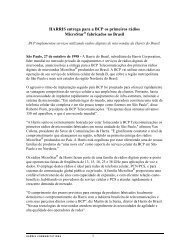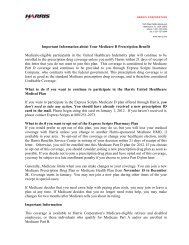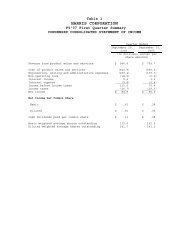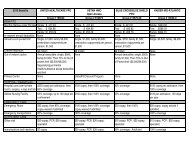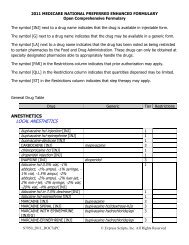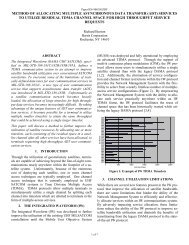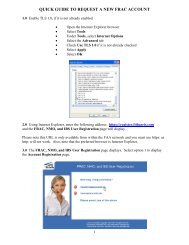harris corporation
harris corporation
harris corporation
Create successful ePaper yourself
Turn your PDF publications into a flip-book with our unique Google optimized e-Paper software.
NOTES TO CONSOLIDATED FINANCIAL STATEMENTS (Continued)<br />
believe that any uncertainties regarding these relevant factors will materially affect our potential liability under the<br />
Superfund Act and other environmental statutes and regulations.<br />
Financial Guarantees and Commercial Commitments — Financial guarantees are contingent commitments<br />
issued to guarantee the performance of a customer to a third party in borrowing arrangements, such as commercial<br />
paper issuances, bond financings and similar transactions. As of July 1, 2011, there were no such contingent<br />
commitments accrued for in our Consolidated Balance Sheet.<br />
We have entered into commercial commitments in the normal course of business including surety bonds,<br />
standby letter of credit agreements and other arrangements with financial institutions and customers primarily<br />
relating to the guarantee of future performance on certain contracts to provide products and services to customers<br />
and to obtain insurance policies with our insurance carriers. As of July 1, 2011, we had total commercial<br />
commitments, including debt and performance guarantees, of $740.3 million.<br />
Financial Instruments and Risk Management — In the normal course of doing business, we are exposed to<br />
global market risks, including the effect of changes in foreign currency exchange rates. We use derivative<br />
instruments to manage our exposure to such risks and formally document all relationships between hedging<br />
instruments and hedged items, as well as the risk-management objective and strategy for undertaking hedge<br />
transactions. We recognize all derivatives in our Consolidated Balance Sheet at fair value. Derivatives that are not<br />
hedges must be adjusted to fair value through income. If the derivative is a hedge, depending on the nature of the<br />
hedge, changes in the fair value of the derivative are either offset against the change in fair value of assets,<br />
liabilities or firm commitments through earnings or recognized in other comprehensive income until the hedged item<br />
is recognized in earnings. The ineffective portion of a derivative’s change in fair value is immediately recognized in<br />
earnings. We do not hold or issue derivatives for trading purposes. See Note 19: Derivative Instruments and<br />
Hedging Activities for additional information regarding our use of derivative instruments.<br />
Income From Continuing Operations Per Share — For all periods presented in this Report, income from<br />
continuing operations per share is computed using the two-class method as it is the more dilutive of the treasury<br />
stock or two-class methods. The two-class method of computing income from continuing operations per share is an<br />
earnings allocation formula that determines income from continuing operations per share for common stock and any<br />
participating securities according to dividends paid and participation rights in undistributed earnings. Our restricted<br />
stock awards and restricted stock unit awards, as well as our performance share awards and performance share unit<br />
awards granted prior to fiscal 2011, meet the definition of participating securities and are included in the<br />
computations of income from continuing operations per basic and diluted common share. Our performance share<br />
awards and performance share unit awards granted beginning in fiscal 2011 do not meet the definition of<br />
participating securities because they do not contain rights to receive nonforfeitable dividends and, therefore, are<br />
excluded from the computations of income from continuing operations per basic and diluted common share. Under<br />
the two-class method, income from continuing operations per common share is computed by dividing the sum of<br />
distributed earnings to common shareholders and undistributed earnings allocated to common shareholders by the<br />
weighted average number of common shares outstanding for the period. In applying the two-class method,<br />
undistributed earnings are allocated to both common shares and participating securities based on the weighted<br />
average shares outstanding during the period. See Note 15: Income From Continuing Operations Per Share for<br />
additional information.<br />
Reclassifications — Certain prior-year amounts have been reclassified in our Consolidated Financial Statements<br />
to conform to current-year classifications.<br />
NOTE 2: ACCOUNTING CHANGES OR RECENT ACCOUNTING PRONOUNCEMENTS<br />
Adoption of New Accounting Standards<br />
In the first quarter of fiscal 2011, we adopted the following accounting standards, neither of which had a<br />
material impact on our financial position, results of operations or cash flows:<br />
• The accounting standard that revises accounting and reporting requirements for arrangements with multiple<br />
deliverables. This standard allows the use of an estimated selling price to determine the selling price of a<br />
deliverable in cases where neither vendor-specific objective evidence nor third-party evidence is available.<br />
Additionally, this standard requires the total selling price of a multiple-deliverable arrangement to be<br />
allocated at the inception of the arrangement to all deliverables based on relative selling prices.<br />
71




